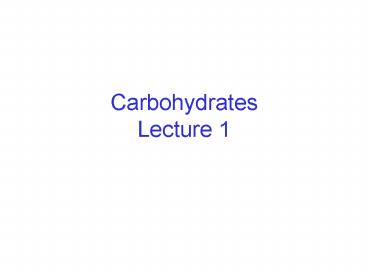Carbohydrates Lecture 1 - PowerPoint PPT Presentation
1 / 44
Title:
Carbohydrates Lecture 1
Description:
Nomenclature. Fischer projections. Lecture 2 : Monosaccharides. Haworth projections ... Monosaccharides nomenclature. Stereochemistry in carbohydrates. Enantiomers ... – PowerPoint PPT presentation
Number of Views:8182
Avg rating:3.0/5.0
Title: Carbohydrates Lecture 1
1
CarbohydratesLecture 1
2
Why Carbohydrates ?
3
Objectives
- Define what a carbohydrate molecule is
- Recognise and classify carbohydrate molecules
- Explain why carbohydrates are important
- Name other molecules that interact with
carbohydrates and explain how and why these
interactions occur
4
Lecture Outline
- Lecture 1 Monosaccharides
- Definition
- Nomenclature
- Fischer projections
- Lecture 2 Monosaccharides
- Haworth projections
- Furanose Pyranose rings
- Modified Sugars
- Sugars in Nucleic Acids
- Lecture 3 Dissaccharides Energy storage
- Glycosidic bond
- Glycolysis
- Lecture 4 Complex Carbohydrates Function
- Starch glycogen
- Cellulose
- Blood groups
- Glycoproteins
5
Outline
- Importance of carbohydrates
- Definition of a carbohydrate
- Monosaccharides nomenclature
- Stereochemistry in carbohydrates
- Enantiomers
- Drawing sugars - Fischer Projections
6
Objectives
- Explain why carbohydrates are important
- Define what a carbohydrate molecule is
- Recognise and classify carbohydrate molecules
- Define stereochemistry and explain its importance
in the structures of carbohydrates
7
Importance of Carbohydrates
- Primary energy store in biosphere
- Energy distribution
- Glycoproteins addresses for intracellular
traffic - Antigenic ABO blood groups
- Structural and mechanical components of cell
walls in plants and insects, cartilage in
vertebrates
8
Importance of Carbohydrates
- Most organisms that live in air obtain energy
from the oxidation of carbohydrates - Glucose is most common simple carbohydrate used
as fuel - Important to consider structure of carbohydrates
- Differences in molecular structure are often
small but critical to their function
9
What is a Carbohydrate?
- Aldehyde or ketone compounds with multiple
hydroxyl groups (OH) - Ketones both groups attached to carbonyl group
are carbon - Aldehydes one carbon and one hydrogen attached
to carbonyl group
Acetaldehyde
Acetone
10
What is a Carbohydrate?
- Simplest carbohydrate molecule is a
monosaccharide (C-H20)n carbon hydrate - Monosaccharides have 3 to 7 carbons
- Either aldehyde or ketone group and hydroxyl (OH)
groups on nearly every carbon - Polyhydroxyaldehydes or Polyhydroxyketones
11
Polyhydroxyaldehydes
Glucose
Galactose
Ribose
R
12
Polyhydroxyketone
R
R
13
Hexose aldo keto
R
R
R
14
Monosaccarides
15
Monosaccharide Nomenclature
16
Which classification fits this sugar?
17
Which classification fits this sugar?
Dihydroxyacetone
18
Which classification fits this sugar?
19
Which classification fits this sugar?
Galactose
20
Which classification fits this sugar?
21
Which classification fits this sugar?
Glyceraldehyde
22
Which classification fits this sugar?
23
Which classification fits this sugar?
D-Threose
24
Which classification fits this sugar?
25
Which classification fits this sugar?
Ketoheptose
Sedoheptulose
26
Stereochemistry
- Stereochemistry study of arrangement of atoms
in 3D space - Carbohydrates with identical functional groups
linked in the same order but with different
spatial orientation - Identical molecules can be made to superimpose by
rotating and flipping - Different compounds cannot be made to superimpose
27
Are these compounds the same?
28
Nonsuperimposable mirror images
29
Different Compounds
- Nonsuperimposable so different compounds
- One carbon atom is chiral (not symmetric)
- Nonsuperimposable mirror images are called
enantiomers
30
Enantiomers
- Stereoisomers are molecules that have the same
bonds connecting the same atoms but different
relative orientations of the bonds - Enantiomer one type of stereoisomer
- Nonsuperimposable mirror images
31
Enantiomers are different compounds
- Different relative orientations of bonds in a
pair of enantiomers cannot be changed by rotation
about the bonds - Only be changed by breaking bonds and remaking
them - One enantiomer can only be changed into another
enantiomer by chemical reaction
32
Stereoisomers important implications
- Starch and cellulose both polymers of glucose
units linked together - C4 of one glucose bonded to C1 of next glucose
- Only difference is the direction of the bond
- Cellulose bond points up, in starch bond points
down - Humans can digest starch but not cellulose
33
Chiral Carbon Atom
Single asymmetric carbon
34
Glyceraldehyde Enantiomers
- Groups attached to an asymmetric carbon atom take
either of 2 fixed positions with respect to other
carbon atoms - -OH group can extend either right or left of the
carbon chain with reference to the CHO and CH2OH
groups
R
L
35
Glyceraldehyde Enantiomers
- Orient molecule so carbonyl is at top
- If hydroxyl (OH) on highest numbered chiral
carbon - to the right D-glyceraldehyde
- to the left L-glyceraldehyde
- Dexter right in latin
- Laevus left in latin
R
L
36
Fischer Projections
- Drawing 2D images representing 3D configuration
of molecule is difficult but possible by using
set of rules - Acyclic compounds drawn so that vertical bonds
represent bonds pointing back and horizontal
bonds are bonds pointing forward
37
Fischer Projections
- Using these rules the distinguishing features of
the 3D structure of stereoisomers can easily and
accurately represented with 2D drawings - Fischer projection named after Emil Fischer who
established the molecular structures of many
sugars
38
Fischer Projections
galactose
Glucose
Galactose
39
Fischer Projections
galactose
C
C
C
C
C
Glucose
Galactose
40
Fischer Projections
41
Fischer Projections
C
D-ribose
42
Fischer Projections
43
Fischer Projections
C
D-glyceraldehyde
44
Lecture 1 Summary
- Why are carbohydrates important?
- Primary energy store
- Structural properties
- Antigenic properties
- What is a carbohydrate?
- Aldehyde or ketone compounds with multiple
hydroxyl groups (OH) - Stereochemistry
- Carbohydrates have identical functional groups
linked in the same order but with different
spatial orientation - Enantiomers
- Drawing sugars
- Fischer projections
- Stereo chemistry































